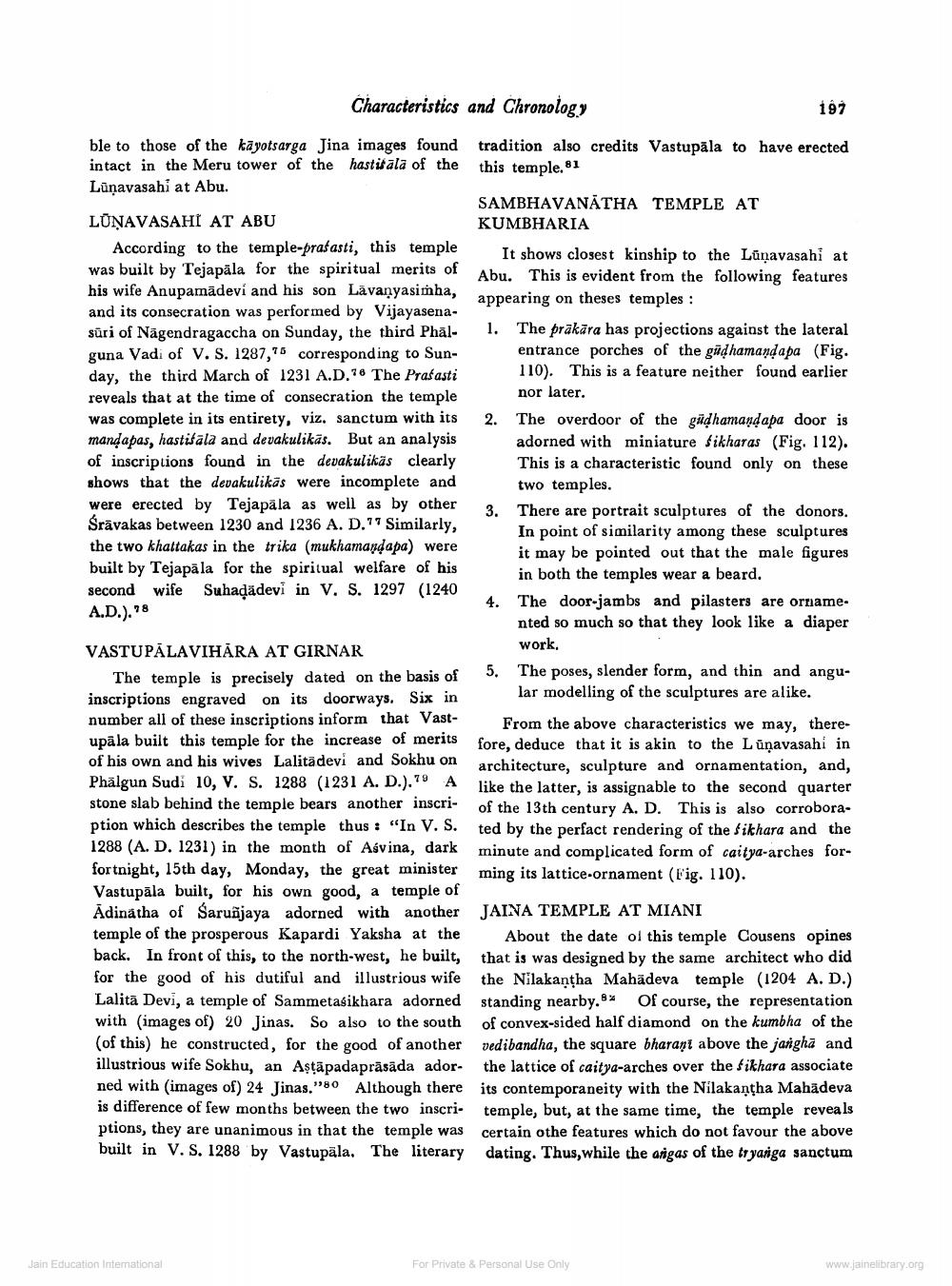________________
Characteristics and Chronology
197
Pes.
3
ble to those of the kāyotsarga Jina images found tradition also credits Vastupäla to have erected intact in the Meru tower of the hastitāla of the this temple. 81 Lūņavasahi at Abu.
SAMBHAVANATHA TEMPLE AT LŪŅAVASAHI AT ABU
KUMBHARIA According to the temple-prasasti, this temple
It shows closest kinship to the Lūņavasahi at was built by Tejapala for the spiritual merits of Abu. This is evident from the following features his wife Anupamadevi and his son Lavanyasimha,
asimaa, appearing on theses temples: and its consecration was performed by Vijayasenasūri of Nagendragaccha on Sunday, the third Phāl. 1. The prakāra has projections against the lateral guna Vadi of V.S. 1287,75 corresponding to Sun- entrance porches of the gūdhamandapa (Fig. day, the third March of 1231 A.D.16 The Prasasti 110). This is a feature neither found earlier reveals that at the time of consecration the temple nor later. was complete in its entirety, viz. sanctum with its 2. The overdoor of the gädhamandapa door is mandapas, hastitala and devakulikās. But an analysis adorned with miniature Sikharas (Fig. 112). of inscriptions found in the devakulikäs clearly
This is a characteristic found only on these shows that the devakulikās were incomplete and two temples. were erected by Tejapāla as well as by other
There are portrait sculptures of the donors. Srävakas between 1230 and 1236 A. D.71 Similarly,
In point of similarity among these sculptures the two khattakas in the trika (mukhamaşdapa) were
it may be pointed out that the male figures built by Tejapāla for the spiritual welfare of his
in both the temples wear a beard. second wife Suhadädevi in V. S. 1297 (1240
The door-jambs and pilasters are orname. A.D.).18
nted so much so that they look like a diaper VASTUPALAVIHĀRA AT GIRNAR
work. The temple is precisely dated on the basis of 5. The poses, slender form, and thin and anguinscriptions engraved on its doorways. Six in
lar modelling of the sculptures are alike. number all of these inscriptions inform that Vast
From the above characteristics we may, thereupāla built this temple for the increase of merits
fore, deduce that it is akin to the Lūņavasahi in of his own and his wives Lalitädevi and Sokhu on
architecture, sculpture and ornamentation, and, Phälgun Sudi 10, V. S. 1288 (1231 A. D.). A like the latter, is assignable to the second quarter stone slab behind the temple bears another inscri- of the 13th century A. D. This is also corroboraption which describes the temple thus : "In V. S. ted by the perfact rendering of the Sikhara and the 1288 (A. D. 1231) in the month of Asvina, dark minute and complicated form of caitya-arches forfortnight, 15th day, Monday, the great minister ming its lattice ornament (l'ig. 110). Vastupala built, for his own good, a temple of Adinatha of Saruñjaya adorned with another JAINA TEMPLE AT MIANI temple of the prosperous Kapardi Yaksha at the About the date of this temple Cousens opines back. In front of this, to the north-west, he built, that is was designed by the same architect who did for the good of his dutiful and illustrious wife the Nilakantha Mahadeva temple (1204 A. D.) Lalitā Devi, a temple of Sammetasikhara adorned standing nearby.8% Of course, the representation with images of) 20 Jinas. So also to the south of convex-sided half diamond on the kumbha of the (of this) he constructed, for the good of another vedibandha, the square bharani above the jangha and illustrious wife Sokhu, an Aştāpadaprāsāda ador. the lattice of caitya-arches over the fikhara associate ned with images of) 24 Jinas."80 Although there its contemporaneity with the Nilakantha Mahadeva is difference of few months between the two inscri- temple, but, at the same time, the temple reveals ptions, they are unanimous in that the temple was certain othe features which do not favour the above built in V. S. 1288 by Vastupala. The literary dating. Thus, while the anigas of the fryaniga sanctum
Jain Education International
For Private & Personal Use Only
www.jainelibrary.org




